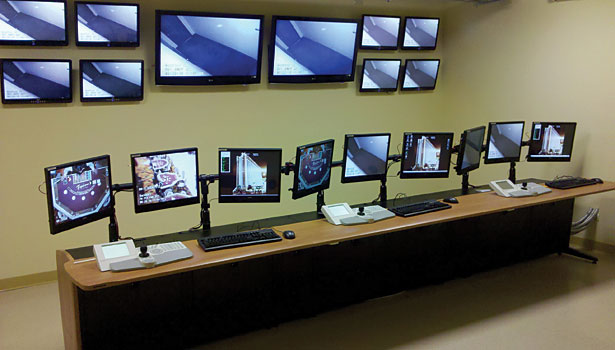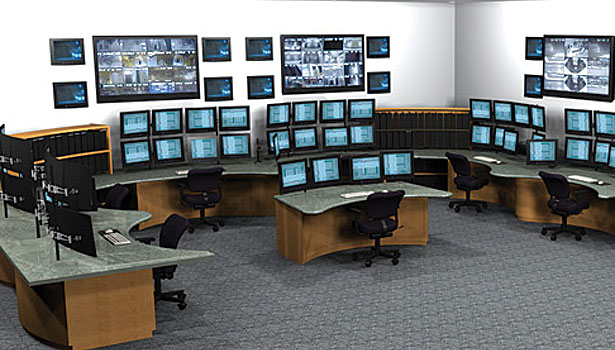Building a Solid Foundation With the Right Racks and Consoles in Your Video Control Room
As furniture, consoles and racks become more advanced to keep pace with new technologies, their importance in the control room design process is no longer the afterthought it once was.

Because operators tend to move between positions, consoles without support legs below the work surface may be desirable for your clients’ control rooms.

A calling card of today’s racks is neater, more professional-looking wiring.

The most high-tech equipment in the world can be rendered useless if a space isn’t properly designed. An ergonomic setup can help operators be less fatigued while increasing efficiency and alertness.

When planning and designing a control room, integrators should aim for a clean, neat-looking installation.




In the world of IP video and megapixel cameras, the less “sexy” product lines can often be overlooked. But in a control room setting, the furniture, cabinets and racks form the backbone of the design.
“We’re low-tech guys in a high-tech world. We’re the last thing you see, but the first thing you need to make it happen,” says Keith Fulmer, president of Stevensville, Md.-based Video Mount Products.
At best, a control room that is set up without regard for this “low-tech” equipment would likely make it difficult for operators to do their jobs properly. At worst, there would be no control room to speak of.
“This equipment is extremely important since, depending on the application, institution, etc., this may be a 24-hour nerve center that gets on the nerves of those who have to disseminate the information that’s going through it. The saying is, ‘poor planning makes for poor performance,’” says Kevin Ditch, engineering director for Lowell Manufacturing, based in Pacific, Mo.
So it’s not just about accommodating the technology. The people working in the control room, and how they will engage with the technology, are just as — if not more — important, meaning furniture can’t be overlooked either.
“The furniture is a very vital part of the control room. It’s what keeps the operators comfortable, healthy and alert so they can be as productive as possible. The console/furniture is the link between the operator and the sophisticated technology used to protect and monitor the operation,” says Brent Leimer, marketing manager for Minneapolis-based Winsted.
Unfortunately, Leimer says, the consoles and furniture often take a back seat to those cutting-edge technologies. But that seems to be changing, he says. “We are optimistic as the increased awareness of workplace health issues is beginning to elevate the importance of consoles, furniture and ergonomics, especially in these 24/7 technology-intensive environments.”
That said, knowing how vital this low-tech equipment is to designing a highly functional control room, you may be wondering just how much thought integrators give to it in the planning stage of a project.
“A knowledgeable and savvy systems integrator will always work to provide a solution that answers current as well as future needs by deploying scalable solutions that incorporate meaningful industry trends such as IP-based camera feeds,” says Mark Tracy, director of product management and business development for Middle Atlantic Products, Fairfield, N.J. “As always, the key to ensuring system reliability is a thorough understanding of infrastructure performance and how to maximize its potential for reliability, efficiency and future growth.”
People and Places
When planning a control room, there are two crucial factors integrators should use to ensure their customer is getting the best return on their investment in furniture, consoles and racks: the space and the people who will work there.
In looking at the room itself, integrators need to consider the size, shape, how the walls are curved, where desks will be placed and more.
“Research says there’s a good, better and best way to design a control room,” Fulmer says. “The room dictates the design.”
Where the people are concerned, Leimer advocates a top-down approach, which he says ensures that decisions on equipment, operating practices, working environments and furniture choices stem from operating demands.
“Everything centers around the operators,” he says. “No matter how well-designed a workstation might be, the overall system will fail if operators are overloaded, undertaking tasks for which they are poorly trained, or straining to read displays that are illegible. With a top-down approach, the limitations of the operator are automatically included and potential mismatches between operator capabilities and system demands are minimized.”
Being aware of guidelines and best practices for maximizing operator comfort and efficiency is key, Tracy says.
“Minimum space per operator should be 32 inches horizontal, the absolute minimum, while over 36 inches is optimal. Because many operators move between positions, the best consoles should be clear of mid-support legs under the entire work surface span,” he says. “Furniture ergonomics that maximize efficiency, mitigate fatigue and maintain alertness for operators should be actively addressed in terms of well-placed display mounts, efficient work surface layouts, effective task lighting and privacy considerations.”
While the room and the people are the two most important factors, they certainly aren’t the only important considerations for integrators.
“There are a lot of other things like ergonomics and tilt angles that play into a good design, so you need flexibility in the products you’re using,” Fulmer says.
Because technologies and equipment change so rapidly, another key factor is the ability of furniture, consoles and racks to accommodate those changes.
“With future expansion in mind, integrators should strive to future-proof control room furniture by using an extensible, open-ended platform,” Tracy says. “Custom furniture is not always necessary or desirable. It’s preferable to maintain usable options by quickly achieving a custom look and functionality from a common platform by using a frame-to-furniture approach.”
It may sound oversimplified, but just being able to use the equipment and furniture is another key factor in control room design.
“Functionality is also important, so the control room design and layout should assure that each operator has access to all control/monitoring sources, including those required in emergency situations,” Tracy says. A not-so-obvious way to do this might be choosing systems that are equipped with virtual control surfaces instead of permanent, dedicated knobs, he adds.
The room’s application, the technologies employed, planned or potential future applications and budget also play key roles as integrators design a control room, Ditch says.
“If they start with these things, for the most part any customer can begin to see the impact and importance,” he says. “Basic design sometimes really doesn’t change.”
Underscoring the importance of future-proof or future-ready equipment is the need for furniture, consoles and racks to be strong and have long-term usability.
“Durability is also a major factor. The furniture in a control room cannot break down without creating serious interruption to the operation, which can result in severe consequences,” Leimer says. “Purpose-built control room consoles are designed with a steel superstructure and ultra-durable work surface options suited for the most demanding 24/7 applications.”
Finally, if a customer thinks he or she can get by with some unused desks and chairs that are taking up space in a storage closet, tell them to think again.
“Standard office furniture is not a viable solution. A professional console provides the proper ergonomics, ample cable management, appropriate cooling for electronics and the flexibility to help future-proof the installation,” Leimer says.
Rack ‘Em Up
When talking about control room furniture and consoles, it’s only natural to include server racks in that conversation, even if those racks are found in a separate room altogether. The rise of IP has led to a number of changes and advancements in rack technology that can, at times, help integrators make lemonade out of spaces that are real lemons.
“The IP stuff is much more important — the network capability and ability to share video not just with the control room but you’re also feeding it to the scene,” Fulmer says. “You’re bringing a lot of video into a smaller area, and that video is going to feed into a number of racks. The amount of video dictates the space. And a lot of times the room is in the back and is not that big or well-ventilated.”
Anyone who has worked with servers — or even used a computer — recognizes that poor or no ventilation can make a real mess of hard drive inner workings. While it’s nothing new, even in the rack space, thermal management technology has improved, opening up more possibilities for placement.
“In terms of racks, IP-based power systems now allow power and temperature monitoring of critical equipment by devices. Digital products, such as video servers, have changed the way cooling systems for enclosures are designed in terms of location, passive or active operation and interconnection formats,” Tracy says.
Today’s racks also allow for neater, more professional-looking installation of wires, which can make servicing the server room a much less daunting task for an integrator than it would be to chase down individual wires to figure out just where the heck they came from.
“Analog was just handled differently. The rooms I see now are just more neat and tidy; it’s a very clean environment,” Fulmer says. “Sometimes the installation is a test for whoever’s going to get the next job. If you come in and see wires everywhere, how are you going to service it? Or you could put the wires out of sight. Time is valuable, so it’s a matter of being an hour vs. five minutes to troubleshoot.”
Knock-Knock
With the combination of the importance of and advances in control room furniture, consoles and racks, integrators can seize on a number of opportunities in that space.
“No matter how large or how small, pretty much every installation presents an opportunity for an integrator to provide a console/furniture solution,” Leimer says. “It is a valuable part of the installation and the end user will appreciate the aesthetics, functionality and flexibility of a professionally designed console.”
That puts the integrator in position to become a trusted source of information on the subject, which can have a positive impact on their bottom line.
“Because integrators are best positioned to specify control room furniture, racks and video display walls, they now have an opportunity to become the technical furniture expert,” Tracy says. “This allows them to interface with and educate the consultant as a means of ensuring they can win the contract for the project and profit from future business.”
There’s even an opportunity for integrators to expand their potential customer base.
“Some guys are stuffing the hardware at their headquarters shop to make it plug-and-play on site. That creates a solution for smaller applications and is defining a broader spectrum of what you could consider a control room,” Fulmer says. “It’s all about the tools, and our products are a set of tools.”
So by thinking outside the box — or inside the box, in this case — savvy integrators can turn these “tools” into a larger part of their business.
4 Experts Offer Advice
As with any technology, there are certain keys for planning, installing and even communicating the value of furniture, consoles and racks that may not be top-of-mind for integrators, let alone customers. Below, those SDM spoke with provide advice to help make the process smoother for integrators before, during, and after a design and installation.
Mark Tracy, Middle Atlantic Products: “As the infrastructure expert, you should listen to your client and plan carefully, considering all task- and event-based functions. Speaking to operators is also important, especially in multi-shift environments. Based on the information gathered, you can make recommendations on reliability, ergonomics, line of sight and optimized video display positioning for technical furniture and video mounting solutions.”
Kevin Ditch, Lowell Manufacturing: “Plan. Many times it is more than standard or custom-designed racks. Not all manufacturers are the same, so do the research.”
Brent Leimer, Winsted: “Take advantage of the opportunity to provide a total solution for the end user. Plan for the console and furniture solution in the beginning stages of the project. Get the console provider involved as early as possible. The end result is a better installation and a happier end user.”
Keith Fulmer, Video Mount Products: “You want to leave a lasting impression and set yourself up to succeed when you need to service the equipment, so clean installation should be the thumbprint of your business.”
6 Key Factors and Considerations
When designing a control room, these are the most important things to consider, according to those interviewed for this story.
- Physical space: size, shape, desk placement
- People: operator space, ergonomics, accessibility of technologies, ability to clearly see monitors
- Equipment: future-proof, expandable
- Control room applications: today and in the future
- Technologies: analog or IP, local or remote storage, for example
- Server racks: number required, placement, expandability, serviceability, budget
Evolving Equipment
Part of the reason furniture, consoles and racks are becoming more top-of-mind for integrators has to do with the way they’ve changed in recent years to accommodate new technologies, particularly IP video. Other drivers to change are ergonomics and the ability to expand easily in the future.
Here are some of the changes that are either continuing or are gaining traction in the market right now.
- Cable management has evolved to accommodate networking, driven by the increased popularity and accessibility of IP.
- Consoles have become more modular, expandable and reconfigurable to accommodate ever-changing technology. For example, highly adjustable monitor arms mounted on a track system provide much greater adjustability to accommodate touchscreens and tablets. Lift-up and sit-stand consoles have become more popular because they reduce fatigue and improve comfort over long periods of time, contributing to greater overall operator health.
- Furniture is available in smaller footprints, making system expansion possible while allowing additional workstations to be added as the system grows without crowding operators.
Looking for a reprint of this article?
From high-res PDFs to custom plaques, order your copy today!











